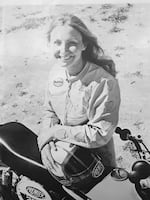There comes a moment in every death-defying feat when there’s no turning back, no way to undo what’s just been done. That is the point of no return.
It’s something that former motorcycle stuntwoman Debbie Lawler is very familiar with.

Debbie Lawler says she was meticulous about her jumps, practicing regularly to make them look effortless and beautiful.
Courtesy of High Desert Museum / Courtesy of High Desert Museum
“I’ve walked that walk,” said Lawler. “I’ve said, ‘I can do one more car. I can do one more jump. I can pull the ramps out 20 more feet.’ That is a true daredevil attitude.”
Lawler’s trick of the trade was jumping her Suzuki TM250 motorcycle, from one ramp to another, across lines of parked cars. Her stage name was “The Flying Angel.” Lawler was good at jumping motorcycles. So good, in fact, that at 21-years-old and just a year into her professional jumping career she flew 101 feet — or 16 pickup trucks — briefly taking the indoor jumping record away from Evel Knievel in 1974.
Around the same time, Denny Edwards and his green Yamaha 650 were the top billing at thrill shows throughout the Pacific Northwest. Edwards, better known as “The Flying Irishman” in his day, was another motorcycle stuntman who preferred to jump overloaded log trucks.
“It’s just the greatest feeling. Euphoria,” said Edwards. “Until reality sets in and it’s like, ‘Oh, I got to do another [show] next week.’”
Edwards and Lawler and their showstopping stunts are featured in a new exhibit at the High Desert Museum in Bend aptly named “Daredevils.” It highlights Oregon’s unique landscapes that drew people both near and far to the state to try their hands at cheating death. People like the Hollywood stuntwoman Kitty O’Neil and, of course, the granddaddy of all modern daredevils, Evel Knievel.
Homegrown heroes

"I didn't really realize or understand what I was doing in motorsports for women," says Debbie Lawler, pictured here in her signature leather jumpsuit. "I was just so thankful and so happy to be doing something that I loved."
Debbie Lawler / Courtesy of Debbie Lawler
Debbie Lawler, 67, was born in Grants Pass, Oregon, and spent her childhood in Medford, where her father introduced motorcycles to her and her two sisters at a young age.
“In Oregon, we’d go hill climbing. We’d go motorcrossing,” said Lawler. “Back then women really were not allowed to ride or race with men at all. My father was always arguing, always pushing the boundaries of the tracks to let his daughters race.”
She started jumping motorcycles when she moved with her family to Arizona in her late teens. It was there that she would spend hours riding in the desert, jumping over ravines carved out by washes. When she was 19, a family friend took notice and invited her to take part in a local thrill show. Lawler said she was all in after that. She broke barriers for women in motorsports along the way.
“It’s a nasty sport and there’s been quite a few [people] that have lost their lives,” said Lawler. “To have a woman step up and do it, people couldn’t even believe it.”
It is a nasty sport indeed. Just a month after breaking Knievel’s record, Lawler nearly lost her own life trying to set another distance record in March of 1974 at the Ontario Motor Speedway near Los Angeles, California.
Lawler said strong Santa Ana winds were blowing the day of the 147-foot jump. And though she did land on two wheels, the winds pushed her farther than she had planned to go and she landed hard. The forceful landing broke her handlebars and with no way to steer while going at speeds of more than 80 miles an hour, Lawler knew she had to bail.
“You can literally see me in the pictures trying to tuck and roll and get off my bike,” said Lawler. “Unfortunately, I went off on the wrong side, into a cement retainer wall, broke my back, had sustained really horrible injuries.”
After six months of recovery, Lawler was well enough to jump again. She performed three more times before hanging up her stunt helmet for good.
Denny Edwards, 75, is from Grand Ronde, Oregon, and he preferred the daredevil business over the family business of logging. The money was better and, as you can imagine, jumping motorcycles was more exciting.
Like Lawler, Edwards also grew up around motorcycles. Both his mother and father rode and he enjoyed flat track racing. He didn’t really consider jumping motorcycles until about 1972 when he came across a magazine article profiling Evel Knievel.

Denny Edwards, pictured above on the bike he performed hundreds of jumps on in the 1970s, says he preferred flat track racing and jumping motorcycles to riding on the highway. “That’s all good,” says Edwards. “Just don’t ask me to ride that bike home.”
Francisca Benitez
“So I took that home, read that article and man, that sounded exciting,” said Edwards. “And it actually had the ramp dimensions: the height and the length of them. The writer had put that in [the story].”
You can probably guess what happened next: Edwards built his own ramp and signed up to perform at a Memorial Day festival in Brookings. With just one practice session under his belt, he successfully landed his first jump over six cars, about 36 feet, in front of a crowded audience.
Edwards made $475 for his very first feat. After that, he went into jumping motorcycles full-time. Edwards estimates he jumped more than 100 times, and visited the hospital on several occasions, in his daredevil career from 1972 to 1985.
“I’ve had eight broken vertebrae, different times, two truck wrecks, one head-on car wreck and the rest on motorcycles,” said Edwards. “But I feel really fortunate to walk away from all of them.”

"You leave that ramp and it's just blue sky," says Denny Edwards, pictured here during one of his many jumps. "You're flying on instruments."
High Desert Museum / Courtesy of High Desert Museum
One other note on Edwards: his daredevil spirit is still strong. Three years ago, at the nimble age of 72, he came out of retirement to perform one last jump in McMinnville. Wearing his shamrock-studded vintage leathers from the 1970s, Edwards successfully made the jump over two semi-trucks. He only broke his back in two different places upon landing.
Daredevils and superheroes
Both Edwards' and Lawler’s stories are chronicled in the current show at the High Desert Museum. The exhibit focuses on the daredevil heyday of the 1970s and the Eastern Oregon landscapes that played host to the risk-takers.
“The high desert has really become a daredevil’s playground,” said Laura Ferguson, the museum’s curator of Western History. “From the really flat playas that make it a great place for setting land speed records, to canyons which are great for motorcycle jumping.”
One of those places is the Alvord Desert, which is home to an extremely flat, evaporated lake bed. It’s where stuntwoman Kitty O’Neil set the women’s land speed record in December of 1976. She piloted the SMI Motivator, a three-wheeled, rocket-powered machine that took her at an average speed of 512.701 mph across the desert floor. O’Neil held that record until last year when Jessi Combs broke it by averaging 522.783 mph, also in the Alvord Desert. Combs died in that attempt due to a mechanical failure that led to a fatal crash.

Kitty O'Neil performed stunts of every kind from crashing cars to jumping out of high rise buildings. She held the record for the fastest woman alive for over 40 years.
Abbott Schindler / Courtesy of High Desert Museum
The exhibit at the High Desert Museum is chock full of memorabilia, photos and other high-flying tales. For example, there’s the story of when Lawler, Edwards and Knievel all crossed paths in Oregon in 1974.
Knievel was in Portland to reclaim his indoor jumping record from Lawler at the Portland Memorial Coliseum in March of that year. He invited Lawler, who was about a month out from her crash at the Ontario Speedway, to watch.
Edwards was also there but not really as a spectator. Knievel’s team asked him to be there as a stand-in performer because they weren’t sure if Knievel, who was recovering from a recent injury, would be well enough to make the jump. If not, they still wanted to put on a good show for the crowd. Edwards was under strict orders not to break any records if he was called upon.
Knievel did end up making the jump that day over 17 vehicles, setting a new indoor record.
Afterward, he gave Lawler a pink mink coat to commemorate her previous achievement. Stitched in white lettering inside: “Happy Landings, Evel Knievel.” The coat is now on display at the museum.
“Not everyone can make that jump or set that land speed record,” said Dustin Cockerham, art and experience director at the High Desert Museum. “The amount of courage and focus it takes is not something everyone can do. That’s how these people became larger than life.”
But if you are looking to get a taste of that point-of-no-return experience, this exhibit has you covered, too. After walking through a mock ring of fire, an ode to a once-popular stunt at thrill shows, visitors can try a hands-free, virtual ramp-to-ramp motorcycle jump.

Stunt motorcyclist Evel Knievel is seen, 1974. Knievel started his motorcycle daredevil career while working at a Honda dealership in Moses Lake, Wash. That’s where he came up with the idea to jump a motorcycle over rattlesnakes and mountain lions as a way to sell more bikes.
Anonymous / AP
Set your parameters: ramp height, jump distance, take-off speed and cross your fingers. A wall-sized screen in front of you does the rest, emulating what the jump might look like if you were riding the motorcycle itself. (I recommend putting your hands on imaginary handlebars for full effect.) If you land on two wheels, take the glory and bragging rights home with you. If not, you can always try again.
Plus, wipeouts are part of what it means to be a daredevil, said Cockerham.
“A lot of people can try something really crazy and get scared away from it,” said Cockerham. “But these people knew the risk. Failure was a part of it and they were able to get back up.”
Perhaps, human resilience is a little something we can all take away from these daredevils. Especially these days, when every day feels like the point of no return and another step into the unknown.
Editor’s note: We have corrected the distance that Debbie Lawler jumped in her record-holding indoor jump. She flew 101 feet.
